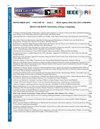眼动追踪在新生儿疼痛评估中的视觉和瞳孔行为
IF 1.3
4区 工程技术
Q3 COMPUTER SCIENCE, INFORMATION SYSTEMS
引用次数: 0
摘要
本文介绍了在新生儿疼痛评估中应用新颖的眼球追踪指标来评估视觉注意力和认知负荷。我们的目标是评估儿科专家,非专家和家长使用相对探索-利用比,以及任务诱发瞳孔反应,同时分析不同的新生儿的正面脸之前和之后的痛苦程序。所有实验都基于考虑临床相关领域的基准图像数据集。Tobii TX300系统被用于在一个封闭的房间里记录眼球追踪数据。我们的研究结果表明,传统指标所描述的视觉注意并不直接对应于所调查的所有样本组参与者各自的注视模式和瞳孔变化,强调只有在使用新指标时,有或没有临床经验的参与者之间的视觉行为才有统计学上的显著差异。本文章由计算机程序翻译,如有差异,请以英文原文为准。
Visual and Pupillary Behavior in Neonatal Pain Assessment using Eye-Tracking
This paper introduces the application of novel eyetracking metrics to assess visual attention and cognitive load in neonatal pain assessment. Our goal is to evaluate pediatrician experts, non-experts, and parents using the relative Explore- Exploit Ratio, along with the Task-Evoked Pupillary Response, while analyzing the frontal faces of distinct newborns before and after painful procedures. All the experiments were based on a benchmark image dataset considering clinically relevant areas of interest. The Tobii TX300 system was used to record the eye-tracking data in a closed room with controlled lighting. Our results disclose that the visual attention described by the traditional metrics does not correspond directly to the respective fixation patterns and pupillary changes quantified for all the sample groups of participants investigated, highlighting statistically significant differences in the visual behavior between participants with or without clinical experience only when using the novel metrics proposed instead.
求助全文
通过发布文献求助,成功后即可免费获取论文全文。
去求助
来源期刊

IEEE Latin America Transactions
COMPUTER SCIENCE, INFORMATION SYSTEMS-ENGINEERING, ELECTRICAL & ELECTRONIC
CiteScore
3.50
自引率
7.70%
发文量
192
审稿时长
3-8 weeks
期刊介绍:
IEEE Latin America Transactions (IEEE LATAM) is an interdisciplinary journal focused on the dissemination of original and quality research papers / review articles in Spanish and Portuguese of emerging topics in three main areas: Computing, Electric Energy and Electronics. Some of the sub-areas of the journal are, but not limited to: Automatic control, communications, instrumentation, artificial intelligence, power and industrial electronics, fault diagnosis and detection, transportation electrification, internet of things, electrical machines, circuits and systems, biomedicine and biomedical / haptic applications, secure communications, robotics, sensors and actuators, computer networks, smart grids, among others.
 求助内容:
求助内容: 应助结果提醒方式:
应助结果提醒方式:


